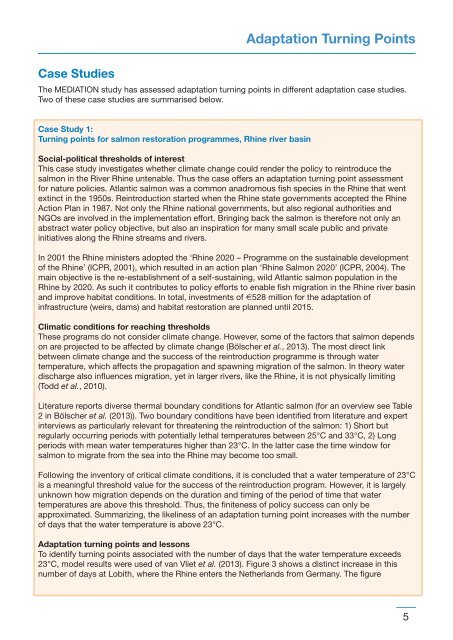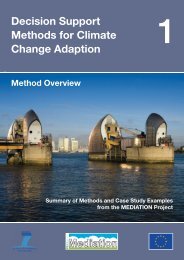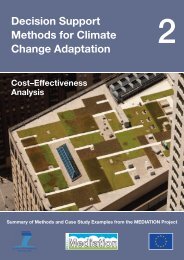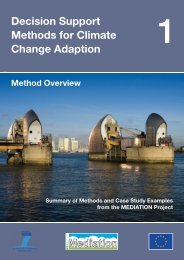Adaptation Turning Points - Mediation
Adaptation Turning Points - Mediation
Adaptation Turning Points - Mediation
You also want an ePaper? Increase the reach of your titles
YUMPU automatically turns print PDFs into web optimized ePapers that Google loves.
<strong>Adaptation</strong> <strong>Turning</strong> <strong>Points</strong>Case StudiesThe MEDIATION study has assessed adaptation turning points in different adaptation case studies.Two of these case studies are summarised below.Case Study 1:<strong>Turning</strong> points for salmon restoration programmes, Rhine river basinSocial-political thresholds of interestThis case study investigates whether climate change could render the policy to reintroduce thesalmon in the River Rhine untenable. Thus the case offers an adaptation turning point assessmentfor nature policies. Atlantic salmon was a common anadromous fish species in the Rhine that wentextinct in the 1950s. Reintroduction started when the Rhine state governments accepted the RhineAction Plan in 1987. Not only the Rhine national governments, but also regional authorities andNGOs are involved in the implementation effort. Bringing back the salmon is therefore not only anabstract water policy objective, but also an inspiration for many small scale public and privateinitiatives along the Rhine streams and rivers.In 2001 the Rhine ministers adopted the ‘Rhine 2020 – Programme on the sustainable developmentof the Rhine’ (ICPR, 2001), which resulted in an action plan ‘Rhine Salmon 2020’ (ICPR, 2004). Themain objective is the re-establishment of a self-sustaining, wild Atlantic salmon population in theRhine by 2020. As such it contributes to policy efforts to enable fish migration in the Rhine river basinand improve habitat conditions. In total, investments of €528 million for the adaptation ofinfrastructure (weirs, dams) and habitat restoration are planned until 2015.Climatic conditions for reaching thresholdsThese programs do not consider climate change. However, some of the factors that salmon dependson are projected to be affected by climate change (Bölscher et al., 2013). The most direct linkbetween climate change and the success of the reintroduction programme is through watertemperature, which affects the propagation and spawning migration of the salmon. In theory waterdischarge also influences migration, yet in larger rivers, like the Rhine, it is not physically limiting(Todd et al., 2010).Literature reports diverse thermal boundary conditions for Atlantic salmon (for an overview see Table2 in Bölscher et al. (2013)). Two boundary conditions have been identified from literature and expertinterviews as particularly relevant for threatening the reintroduction of the salmon: 1) Short butregularly occurring periods with potentially lethal temperatures between 25°C and 33°C, 2) Longperiods with mean water temperatures higher than 23°C. In the latter case the time window forsalmon to migrate from the sea into the Rhine may become too small.Following the inventory of critical climate conditions, it is concluded that a water temperature of 23°Cis a meaningful threshold value for the success of the reintroduction program. However, it is largelyunknown how migration depends on the duration and timing of the period of time that watertemperatures are above this threshold. Thus, the finiteness of policy success can only beapproximated. Summarizing, the likeliness of an adaptation turning point increases with the numberof days that the water temperature is above 23°C.<strong>Adaptation</strong> turning points and lessonsTo identify turning points associated with the number of days that the water temperature exceeds23°C, model results were used of van Vliet et al. (2013). Figure 3 shows a distinct increase in thisnumber of days at Lobith, where the Rhine enters the Netherlands from Germany. The figure5





